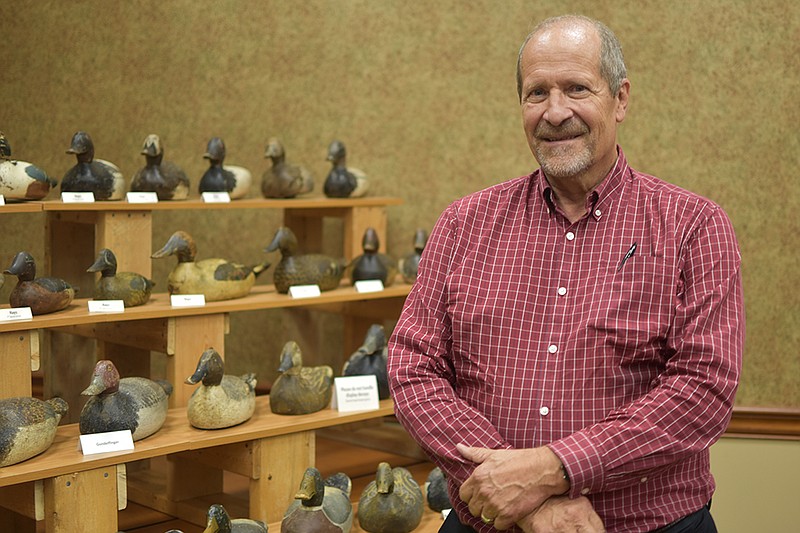Some people collect stamps, baseball cards or books.
Dr. Greg Renner collects duck decoys.
The Columbia man’s collection focuses on decoys produced by the Hays, Gundelfinger and Benz companies in Jefferson City. The companies manufactured decoys between the early 1920s and 1945, selling various different models worldwide.
The Historic City of Jefferson hosted a lecture by Renner on the history of decoy and wood products production in Jefferson City on Thursday night in the Clydesdale Room at N.H. Scheppers Distributing. Renner detailed the history and uniqueness of the decoys and the companies that produced them.
Hays, Gundelfinger and Benz produced wood products — including duck decoys, car bumpers, toys and outdoor furniture — from 1911-45. Production of wood products in Jefferson City began in the Missouri State Penitentiary, where the successor to the J.M. Hays Wood Products company — the J.S. Sullivan Saddle Tree Company — produced saddle trees using inmate labor.
The J.M. Hays Wood Products company started production of duck decoys in the early 1920s, with the first advertisement featuring “True-to-Life” decoys being published in 1921.
Hays and its successor, the Gundelfinger Wood Products company, produced decoys at a facility located on present-day Industrial Drive. Gundelfinger’s successor, the Benz Wood Products Company, continued decoy production on present-day Missouri Boulevard after the Industrial Drive facility was sold to the Oberman Pant Company.
Over a century after the first decoys were produced, Renner and several others collect and research the decoys made in Jefferson City. Meanwhile, the Industrial Drive and Missouri Boulevard facilities still stand.
Today, the decoys are known for their high quality and uniqueness. Renner said the Jefferson City-made decoys were more durable than the decoys produced by other companies, such as the Mason decoys, because of the grain pattern used.
“Many, many Masons have splits in them,” he said. “They have great painting, great form and everyone loves them, but they have cracks in them. The outer rings of wood tends to dry out more than inner rings and you get a splitting. … (T)hat’s what Hays seemed to have recognized and that went on through the other factories as well.”
While Renner believes the Jefferson City-made decoys are “underrecognized and undervalued” in the decoy collecting community, certain traits — such as the aforementioned grain pattern and a scratch and comb painting style — make them desirable to many.
“Jefferson City people became very expert at this idea of scratch and comb painting,” Renner said. “If you can find birds, or decoys, in pretty mint condition or in very good condition that have that trait, they’re desirable pieces to enjoy.”
Renner has assembled a study group dedicated to researching the history of Jefferson City-made decoys and correctly identifying them. He said many decoys are misidentified, which is what made him dive deeper into researching the history behind them.
“I was buying birds (decoys) and later decided, for different reasons, they were not actually Hays decoys and realized the reporting in the books was inaccurate,” Renner said.
Renner said the study group consists of collectors from Maryland, Pennsylvania, New Mexico, Iowa and Arizona.
While decoy manufacturing in Jefferson City stopped in 1945, the products of local talent has not been forgotten.
“I think it was admirable what Jefferson City was able to do in the time they did it,” Renner said. “I think they made a good product, and it filled a big niche in the decoy hunting world.”

